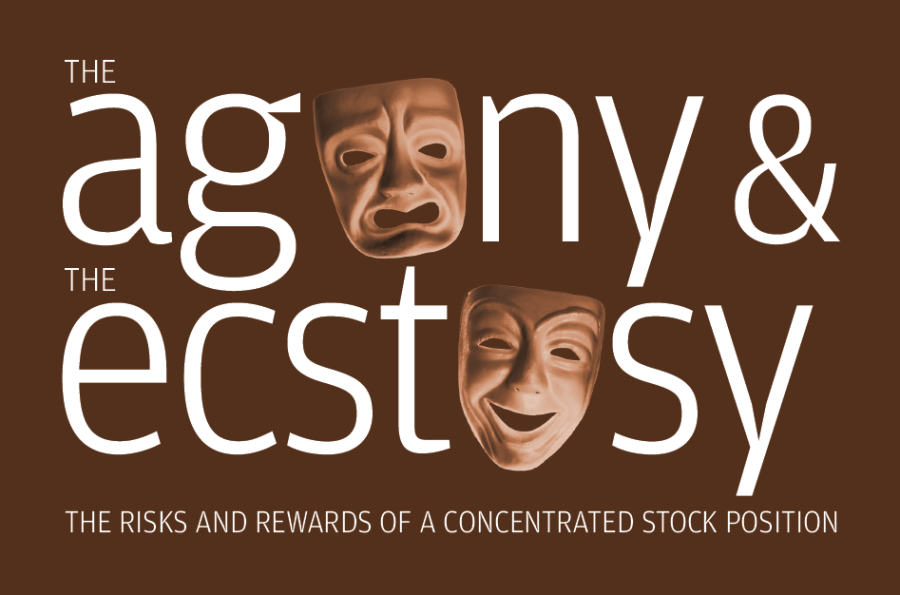StockShield to Sponsor NCEO’s 2015 Employee Ownership Conference
More than 1,400 Attendees Expected at Country's Premiere Gathering on Employee Ownership

StockShield is proud to sponsor the 2015 Employee Ownership Conference being held April 20-23 at The Sheraton Denver Downtown Hotel in Denver, Colorado. As the nation’s premiere gathering on employee ownership, the National Center for Employee Ownership’s annual conference features interactive presentations and lectures from hundreds of top employee ownership experts and experienced leaders from successful employee-owned companies.
J.P. Morgan Quantifies Risks and Rewards of a Concentrated Stock Position
40% of Russell 3000 stocks have suffered a permanent 70%+ catastrophic loss

J.P. Morgan has published a 42-page study entitled The Agony & The Ecstasy: The Risks & Rewards of a Concentrated Stock Position. Analyzing both S&P 500 and Russell 3000 stock performance from 1980 through 2014, J.P. Morgan reached several sobering conclusions:
- Over the past 25 years, there has been substantial “creative destruction.” Even in the S&P 500 — the most prestigious index of American business — an estimated 320 companies were removed for reasons of business distress. “What this tells us is that companies, even very successful ones, face a steady drumbeat of competitive, regulatory and operational risks.”
- Approximately 40% of all Russell 3000 companies have suffered a permanent 70% decline in their stock’s value, often due to factors outside of management’s control. These exogenous factors include commodity price risks, changes in U.S. or foreign government policy on tariffs and/or trade, unconstrained expansion by competitors, and technological innovation. “Even the best management team is hard-pressed to cope with these types of unforeseeable challenges.”
- A “meaningful number of companies” are always “suffering sharp, unrecovered price declines at any given time, even during an economic expansion.”
While acknowledging that stock concentration can be an effective engine of wealth creation, it concluded that “continued concentration may ultimately destroy wealth.”
StockShield’s patented risk management solutions — both the Stock Protection Fund and ESOP Protection Trust — are premised on the harsh realities that J.P. Morgan highlights: the loss of wealth caused by continued stock concentration with no protection in place. Our primary objective is to reduce the number of large losses caused by stock concentration while preserving the opportunity for concentrated stock holders to generate substantial wealth well in excess of broad market returns.

Further Reading
- Executive Summary September 30, 2014 View Article
- Full Report September 30, 2014 View Article
ESOP Companies and Fiduciaries Can Successfully Manage ESOP Risk
Supreme Court Decision Highlights Fiduciary Issue for ESOP Companies

Employee Stock Ownership Plans (ESOPs) are one of the best ways to accumulate substantial retirement savings, according to the National Center for Employee Ownership, but they are not without risk, as demonstrated by last week’s Supreme Court decision in Fifth Third Bancorp v. Dudenhoeffer. In that case, Fifth Third’s ESOP lost 74% of its value.
In its decision, the Supreme Court ruled unanimously that ESOP Fiduciaries are not entitled to a “presumption of prudence” when buying, holding, or selling company shares. In other words, ESOP Fiduciaries are subject to the same standard of prudence as other ERISA Fiduciaries. However, failing to diversify the ESOP is not evidence of a lack of prudence, given that the whole purpose of an ESOP is to invest primarily, if not entirely, in company stock.
In reaching its decision, the Court established a new set of standards for plaintiffs to demonstrate that a fiduciary is imprudent. While these apply primarily to publicly traded companies, and legal experts expect the decision to have little direct impact on privately held ESOPs, it does refocus attention on the issue of fiduciary risk that has always been present for closely-held ESOP companies.
No Free Pass
While diversification is not required, the Court made it clear that ESOP Fiduciaries do not get a free pass just because the plan is an ESOP. If a company’s stock falls precipitously, litigation risk remains a significant issue, even if the company has done all the right things in making decisions about buying, holding, and selling shares. The plaintiff’s bar and the Department of Labor are likely to remain active in this field and may be emboldened by the Court’s decision.
A variety of circumstances could unfold making company stock appear an imprudent investment (i.e. unlikely to provide financial retirement benefits to participants and beneficiaries). Although past history suggests that companies that use proper appraisal and fiduciary processes are likely to prevail, litigation can be extraordinarily costly and time consuming, and there is no guarantee that a court will not see things differently. Aside from litigation risk, moreover, most companies feel an obligation to employees to provide a good retirement benefit.
Managing Risk
ESOP Companies and Fiduciaries can successfully respond to this new legal landscape by mitigating the risk of their ESOP’s company stock without limiting its upside potential.
The ESOP Protection Trust pools cash from strong mature ESOP companies and uses that cash to reimburse eligible losses on company stock after a 5-year or 10-year term. If there are no losses over that time, all ESOP companies get their money back from the ESOP Protection Trust while ESOP participants retain their stock’s full upside gain (i.e. substantial retirement savings).
Corey Rosen, founder of the National Center for Employee Ownership, says, “This is an important step for ESOPs and one that can substantially strengthen plans. Companies should seriously consider it.”
Rosen recently joined the Board of Directors of StockShield, Inc., the SEC-registered broker-dealer that’s been developing the ESOP Protection Trust for the past two years.
In the “Post-Dudenhoeffer” world, the ESOP Protection Trust can help ESOP Companies and Fiduciaries in at least three ways:
- Deter Litigation. Lawsuits are filed when company stock loses value. By helping prevent losses to the ESOP, the ESOP Protection Trust acts as insulation against the substantial cost and distraction of ERISA litigation (e.g. motions to dismiss, class certification, discovery, trial, and beyond).
- Prevent Personal Liability. ESOP Fiduciaries, including potentially Directors and Officers, can be held personally liable for holding company stock in ESOPs if the stock price falls and Fiduciaries failed to act to prevent the losses.
- Improve Likelihood of Achieving Early Motion to Dismiss. In the event of litigation, participation in the ESOP Protection Trust can be a powerful affirmative defense in demonstrating that Fiduciaries acted prudently and did not fail to act to prevent losses, helping secure an early motion to dismiss.